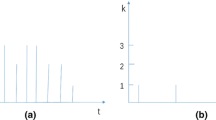Abstract
A new index - Relative Publication Growth (RPG) - was suggested for characterizing the annual increase of publications in different selected periods. It has been revealed that the mean citedness of papers (“Chance for Citedness”) increases parallel with increasing RPG and growing mean number of references in papers. The number of citations attainable by a paper published in a given journal may be estimated by multiplying the resp. Journal Citedness Factor (JCF) with the Garfield Factor of the resp. journal. The JCF values may represent the aging of information whereas GF-s the potential frequency of citations.
Similar content being viewed by others
References
Baldi, S., L. L. Hargens (1997), Re-examining Price's conjectures on the structure of reference networks. Results from the special relativity, spatial diffusion modeling and role analysis literatures, Social Studies of Science, 27: 669–687.
Gomperts, M. C. (1968), The law of constant citation for scientific literature, Journal of Documentation, 24: 113–117.
Menard, H. W. ( 1971), Science: Growth and Change, Harvard University Press, Cambridge, Mass.
Peterson, C. J. (1988), Citation analysis of astronomical literature: Comments on citation half-lives, Publications of the Astronomical Society of the Pacific, 100: 106–115.
Plomp, R. (1994), The highly cited papers of professors as an indicator of a research group's scientific performance, Scientometrics, 29: 377–393.
Price, D. De Solla (1970), Citation measures of hard science, soft science, technology and non-science, In: C. E. Nelson, D. K. Pollock (Eds), Communication among Scientists and Engineers, Heath Lexington, Mass.
Rousseau, R. (1992), Why am I not cited or why are multi-authored papers more cited then others? Journal of Documentation, 48: 1.
Schubert, A., W. GlÄnzel (1983), Statistical reliability of comparisons based on the citation impact of scientific publications, Scientometrics, 5: 59–74.
Stinson, E. R., F. W. Lancaster (1987), Synchronous versus diachronous methods in the measurement of obsolescence by citation studies, Journal of Information Science, 13: 65–74.
Vinkler, P. (1998), Comparative investigation of frequency and strength of motives toward referencing. The reference threshold model, Scientometrics, 43: 107–127.
Vinkler, P. (1999), Ratio of short term and long term impact factors and similarities of chemistry journals represented by references, Scientometrics, 46: 621–633.
Vinkler, P. (2000), Publication velocity, publication growth and impact factor: An Empirical Model. In: (B. Cronin, H. B. Atkins (Eds), The Web of Knowledge, A Festschrift in Honor of Eugene Garfield, ASIS Monograph Series, Medford, New Jersey: Information Today Inc. pp. 163–176.
Vinkler, P. (2000), Evaluation of the publication activity of research teams by means of scientometric indicators, Current Science, 79: 602–612.
Author information
Authors and Affiliations
Rights and permissions
About this article
Cite this article
Vinkler, P. Dynamic changes in the chance for citedness. Scientometrics 54, 421–434 (2002). https://doi.org/10.1023/A:1016086500801
Issue Date:
DOI: https://doi.org/10.1023/A:1016086500801




